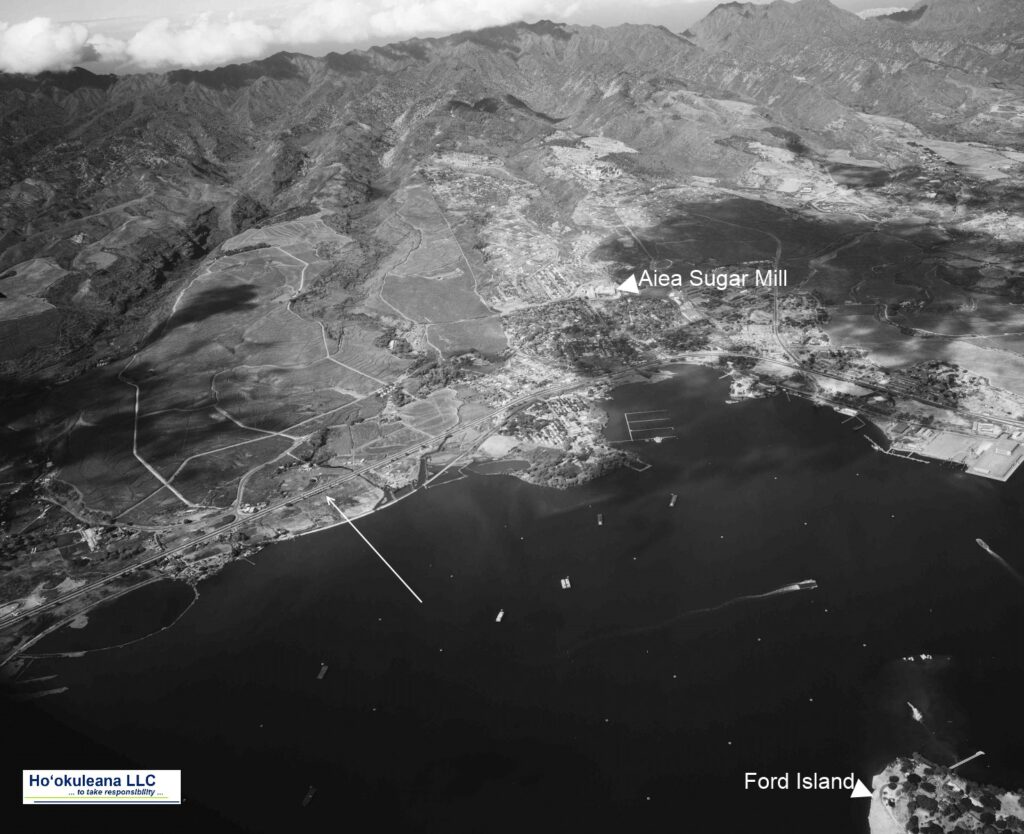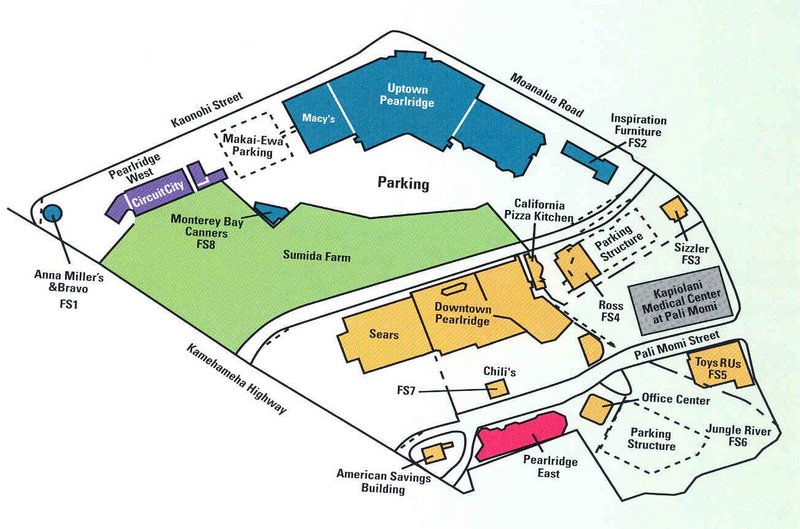During ancient times, various land divisions were used to divide and identify areas of control. Islands were divided into moku (districts;) moku were divided into ahupuaʻa. A common feature in each ahupuaʻa was water, typically in the form of a stream or spring.
The Island of Oʻahu has six Moku: Kona, Koʻolaupoko, Koʻolauloa, Waialua, Waiʻanae and ʻEwa. The Waiʻanae ahupuaʻa, within the moku has an un-typical shape – it is sometimes referred to in two parts: Waiʻanae Kai, on its western side, runs from the ocean to the Waiʻanae Mountains (like a typical ahupuaʻa – this portion of Waiʻanae runs from the mountain to the sea.)
From there, however, the section referred to as Waiʻanae Uka continues across Oʻahu’s central plain and extends up into the Koʻolau Mountains – extending approximately 15-miles from the Waianae Mountains to the Koʻolau Mountains and ends up overlooking the windward coastline. (Each section is within the same ahupuaʻa.)
Wahiawā, situated in Waiʻanae Uka, was from very ancient times, identified with the ruling aliʻi of Oʻahu. The name breaks down to Wahi (place), a (belonging to), wa (noise.) (Handy)
Perhaps the name goes back to the time when Hiʻiaka was in this general area and could see waves dashing against the coast afar off and hear the ocean’s ceaseless roar… (Handy)
The chiefs of Līhuʻe, Wahiawā, and Halemano on Oʻahu were called Lo chiefs, poʻe Lo Aliʻi (”people from whom to obtain a chief”,) because they preserved their chiefly kapus…
They lived in the mountains (i kuahiwi); and if the kingdom was without a chief, there in the mountains could be found a high chief (aliʻi nui) for the kingdom. Or if a chief was without a wife, there one could be found – one from chiefly ancestors. (Kamakau)
A “sizable population” filled the Wahiawā area in traditional Hawaiian times, based on the “various areas of loʻi northwest of the present town of Wahiawā. … There were extensive terraces that drew water from Wahiawā Stream, both above and below the present town.”
“There were many small terrace areas along the sides of the valleys of all the streams of this general area. … The peculiarity of this area, apart from distance from the sea, is that it is the only extensive level area on (Oʻahu.)” (Handy)
In more modern times, at the height of the sandalwood boom, Kamehameha was buying foreign ships, including six vessels between 1816 and 1818, to transport his own wood to the Orient. (Kuykendall) According to Kamakau, Wahiawā was a prime source for the valuable wood; the largest trees were from Wahiawā.
Over the remainder of the decade, the population fluctuated. Things changed at the end of the decade. Following the overthrow of the Hawaiian monarchy, western military and agricultural interests would transform the Wahiawā landscape.
Land that had previously been leased to Oʻahu businessman James Robinson for cattle grazing was designated Wahiawā homestead land by The Land Act of 1895 (as homestead land, including water rights from the Kaukonahua Stream (not DHHL homestead, this was for general homesteading.))
Then, in 1897, Californian, Byron Clark, became the Hawaiian Republic’s commissioner of agriculture. In looking for land for him to settle on, he learned of the availability of land at Wahiawā.
Clark organized a group of other Californians (as well as others) to join him in settling the whole tract of thirteen hundred acres — which became known as the Wahiawā Colony Tract. Having formed an agricultural cooperative called the Hawaiian Fruit and Plant Company, the homesteaders began formalizing and refining the physical organization of their Wahiawā settlement.
To reach Wahiawa, the homesteaders forded the north and south forks of Kaukonahua Stream which surrounds Wahiawa, making it an island within an island. Life was hard but they cleared the land and planted their required fruit trees and crops.
They built a one-lane bridge, constructed homes, laid out roads, obtained water rights, built a store and post office, and saw to it their children were educated. In a very short time the homesteaders had a community and started the pineapple industry.
Clark found some discarded pineapple slips which he shared with Alfred W Eames and in 1900 they harvested their first crop in the community. Clark experimented in his home kitchen to can the fruit in glass jars.
Eames founded the Hawaiian Island Packing Company and built his first cannery in the Wahiawā heights area in 1902. This company was later known as Del Monte Fresh Produce (Hawaii) Inc.
Another homesteader and planter, Will P Thomas, operated under the Thomas Pineapple Company, which in 1917 following his death, became Libby McNeill & Libby of Honolulu.
Initially each settler lived in a house on his five-acre parcel in the town site and farmed his other land in the surrounding area. It was soon discovered, however, that each settler preferred to reside on his own farmstead, holding his town lot in reserve.
The homesteaders abandoned the village plan and agreed that one man, Thomas Holloway, would live on their 145-acre central lot site.
On August 27, 1902 a trust deed, referred to as the Holloway Trust, formally set aside the central town lots for the use and benefit of the Settlement Association of Wahiawā resident landowners. Within a few years, Wahiawā Town was underway.
Some of the town’s streets would be named for the early homesteaders – including Clark, Kellogg, Thomas and Eames streets (initial mapping shows California Avenue as the first, and main, road.)
Another notable change at this time was the result of a presidential order of July 20, 1899 setting aside Waianae Uka lands as the military reservation. Ten years later, in 1909, these lands would become the site of Schofield Barracks, named after Lt. General John M. Schofield.
Another homesteader to the area was James D Dole, who moved to Wahiawā in 1900 to attempt farming on 61-acres. Dole described Wahiawā at the beginning of the 20th century as “a park-like stretch of some 1,400-acres of third-class pasture land, dotted with shacks of 13 hopeful homesteaders for whom (the) general sentiment was merely pity.”
Dole founded Hawaiian Pineapple Company in 1901. He built a cannery next to his pineapple fields in Wahiawā and packed his first cans in 1903. By 1904, Wahiawā was known as “The City of Pines” and was considered the “hub” of the pineapple industry in the world.
Within a few years pineapple production at Wahiawā had increased that Dole planned a cannery at Iwilei, near the shipping facilities of Honolulu Harbor. Today his Hawaiian Pineapple Company (HAPCO) is known as Dole Food Company, Hawaii.
In order to transport the pineapple from Wahiawā to Honolulu, Dole persuaded the Oʻahu Railway & Land Company to extend its rail line to Wahiawā. The line to Wahiawā was constructed in 1906.
Another change occurred on January 23, 1906 when the Wailua Agricultural Company, later known as Waialua Sugar Company, constructed the Wahiawā Dam and Reservoir, a 2.5-billion-gallon capacity reservoir (the largest in Hawaiʻi;) it is generally known as Lake Wilson, today.
Another “story that has never been told in Hawaii” were the events of December 7, 1941 in Wahiawā. While the incident is usually called “the bombing of Pearl Harbor,” other areas on O‘ahu were also shelled. In Wahiawā two civilians died, 22 were injured, and two houses were burned down.
Sixty-seven-year-old Soon Chip Kim was sitting in a Wahiawa plantation cafeteria when the town was fired upon. The bullets went through the roof, killing Kim.
Richard Masaru Soma, 22, was waiting at a bus stop on Kamehameha Highway for a ride to go fishing with a friend when Wahiawā town was strafed by enemy fire. Soma was injured and died five days later. (Napoleon)
In addition to the two civilian casualties, 22 people were injured in Wahiawā. Dr. Merton Mack, who Purnell said was the only physician in town at the time, treated the injured at his clinic on the corner of California Avenue and Kamehameha Highway.
The enemy also suffered casualties in Wahiawa. According to Purnell, a Japanese plane, engaged in a dogfight with an American plane, was hit and crashed into the Hawaiian Electric substation on Neal Avenue, killing the pilot and co-pilot. On its way down, the plane clipped a house, setting it ablaze. The fire spread to a neighboring home, destroying both buildings.
The start of World War II further helped to accelerate developments within Wahiawā to accommodate the needs of the growing military population. Wahiawā Elementary School, which started in 1899 to educate children of farmers who were brought in from California, closed their doors in the 1940s to become the new Wahiawā General Hospital.
At the end of World War II, the facility continued to remain in operation under the leaders of the Wahiawā Hospital Association. The 72-bed acute care facility was dedicated in 1958, under the official name, Wahiawā General Hospital.
Post World War II, the old Wahiawā Hotel had been used as living quarters for area school teachers. By the 1960s, Wahiawā teachers, who had been quartered at the teachers’ cottages (as they referred to them), were forced to relocate as plans for the new Wahiawā Branch Library were underway; the library opened on July 19, 1965. (Lots of information here from Cultural Surveys and Wahiawā Historical Society.)



























































